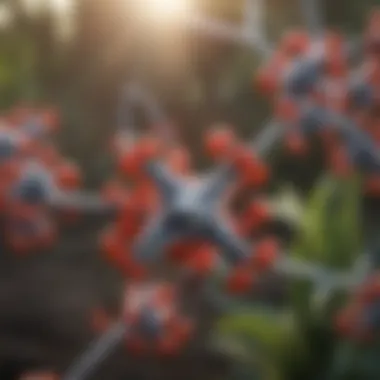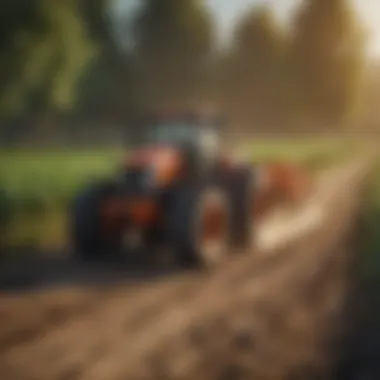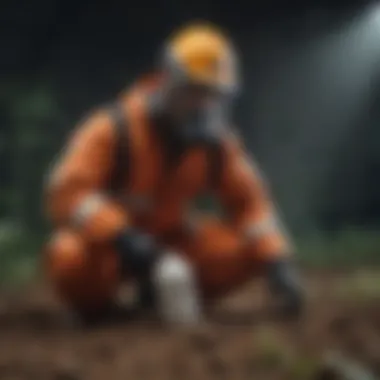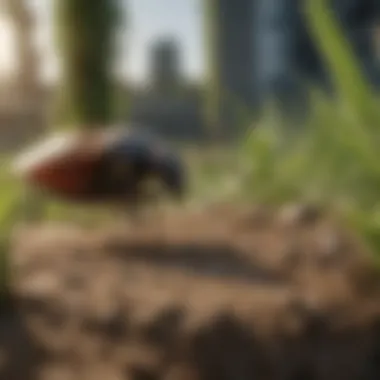Triazicide Bug Killer: Comprehensive Insights and Applications


Overview of the Topic
Definition and Importance
Triazicide bug killer is a specific type of pesticide used primarily in agriculture and horticulture. It is effective against a wide range of insects that can harm plants. This chemical is vital for ensuring the health of crops, maintaining yield levels, and controlling pest populations. Farmers and gardeners are often compelled to turn to such solutions to mitigate damage from pests, which can lead to significant economic losses if not managed properly. Its effectiveness makes it a common choice among pest management strategies.
Current Trends
The use of triazicide is evolving. Many agricultural professionals are seeking ways to incorporate triazicide while also considering environmental impacts. Products that combine effectiveness with lower toxicity are in higher demand. Additionally, there is a growing trend towards integrated pest management. This approach looks at the pest issue from a holistic perspective, combining chemical controls with biological and cultural practices. As awareness grows around sustainability, less harmful alternatives to traditional triazicides are being explored, making this a fascinating field of study in pest management.
Key Techniques and Practices
Step-by-Step Guide
- Identify the Pest:
Knowing what type of insect is affecting the plants is crucial. Identification helps in choosing the right product. - Select the Right Triazicide:
Choose a triazicide product that targets the specific pest. Some common products include Ortho Bug B Gon and Spectracide Triazicide. - Preparation:
Read the labels carefully. Prepare the mixture in accordance with the manufacturer's instructions. - Application:
Apply the triazicide during cooler parts of the day to minimize evaporation and maximize effectiveness. Ensure thorough coverage on the plant's foliage. - Post-Application Care:
Monitor the plants regularly after application. Follow up treatments as needed and assess effectiveness.
Tools and Equipment Needed
- Sprayer: A hand-held or backpack sprayer can provide even coverage.
- Protective Gear: Gloves, masks, and goggles are essential for safety during application.
- Measuring Equipment: Accurate measuring cups to ensure the correct dosage.
Challenges and Solutions
Common Obstacles
Despite its effectiveness, triazicide use can come with challenges. Non-target species may be affected, leading to ecological imbalances. Additionally, pests can develop resistance to triazicides over time, reducing their efficacy.
Innovative Solutions
To counter these challenges, farmers are encouraged to rotate pest control methods. For example, using biological pest control in conjunction with triazicide can help manage resistance. Continuous education on pest management practices can also enhance their effectiveness, ensuring that farmers adapt to changing environmental conditions.
"Understanding the balance of chemical use in agriculture is crucial for sustainable pest management practices."
The above strategies provide not only a comprehensive view of triazicide bug killer but also insight into managing pests effectively and responsibly.
Understanding Triazicide Bug Killer
Triazicide Bug Killer serves as a critical tool in pest management for both agricultural and horticultural applications. Understanding its various components is essential for professionals who aim to enhance productivity while ensuring the health of their crops and plants. Triazicide is clinically recognized for its effectiveness against multiple pests, which underscores its importance in the toolkit of modern pest control.
Chemical Composition
Active Ingredients
Active ingredients in Triazicide, primarily Triazole compounds, provide the necessary lethality against insects. One key characteristic of these ingredients is their broad-spectrum efficacy, which allows them to target a wide range of pests. This versatility makes them a favored choice among farmers and gardeners. The unique chemical structure of Triazoles contributes to their high absorption rates in plants, promoting effective pest control with lower application rates. However, these advantages are sometimes offset by concerns about potential over-reliance and resistance development in target pest populations.
Mechanism of Action
The mechanism of action for Triazicide involves the inhibition of certain enzymes crucial for insect growth and development. This characteristic is particularly beneficial because it disrupts the normal life cycle of pests, leading to significant population decline. The specific action targets metabolic processes unique to insects, minimizing harm to non-target species. Nevertheless, while effective, this mechanism necessitates careful consideration of application methods to avoid collateral damage in the ecosystem.
Chemical Properties
Triazicide possesses chemical properties that enhance its stability and effectiveness. One critical aspect is its solubility in water, which aids in comprehensive distribution when applied. This key characteristic enhances pest control efficacy in varied conditions, including wet and dry environments. Nonetheless, the persistence of Triazicide in soil and vegetation can raise concerns regarding environmental contamination, underlining the importance of informed application practices.
Forms Available
Granules
Granules represent a form of Triazicide that is particularly user-friendly for granular applications. They are easy to apply and can offer longer residual action compared to liquid forms. This characteristic makes granules a beneficial choice for farmers seeking extended pest protection. The uniqueness of granules lies in their ability to slowly release active ingredients into the soil, which can result in a prolonged effect against target pests. However, on the downside, improper application can lead to uneven distribution and potential runoff into nearby water sources.
Concentrates
Concentrates are another valuable form of Triazicide. They are highly concentrated solutions that require dilution before application. This key characteristic allows for flexibility in dosage, making them attractive for large-scale agricultural use. They provide effective control over a wider area when compared to other forms. However, the need for mixing may be seen as a disadvantage for some users as it introduces a risk of mishandling and inaccuracies in application rates.
Ready-to-Use Solutions
Ready-to-use solutions simplify the process of applying Triazicide. These products come pre-mixed, making them accessible to both novice and experienced users. One major advantage is the eliminated risk of improper dilution. This ease of use has made ready-to-use solutions a popular choice for home gardeners and small-scale operations. However, the convenience comes at a higher cost per application, which may be a deciding factor for large agricultural settings.


Applications of Triazicide in Agriculture
The role of Triazicide in agriculture cannot be understated. Its application significantly impacts pest management strategies. Triazicide serves as an effective solution for controlling various agricultural pests. Understanding the specific usages is essential for maximizing both efficiency and yield in farming practices. Farmers face challenges including pest resistance, environmental factors, and crop health. Knowledge of how to implement Triazicide properly can enhance agricultural productivity.
Target Pests
Common Agricultural Pests
Common agricultural pests include aphids, whiteflies, and spider mites. These pests are known for their rapid reproduction and potential to cause severe damage. Triazicide targets these pests effectively, making it a valuable resource for farmers. The ease of application further contributes to its popularity. The unique feature of these pests is their ability to transmit diseases to plants, which can lead to reduced crop yields. Hence, controlling these pests with Triazicide is critical for maintaining healthy crops.
Diagnosis of Infestations
Timely diagnosis of infestations is crucial for effective pest management. Identifying the presence of pests early can limit the damage they cause. Methods such as visual inspections and sticky traps help in diagnosing pest problems. This process enhances the overall efficacy of Triazicide use by ensuring it is applied at the correct time. Proper diagnosis addresses not only the symptoms of the pest issue but also helps in understanding the underlying causes. In agriculture, this precision is key to sustaining high crop yields.
Impact on Crop Yields
The impact of pests on crop yields is significant. Infestations can lead to direct damage to crops or indirectly reduce their growth potential. Triazicide can mitigate these effects, thus maintaining or improving yields. For instance, a timely application can lead to healthier plants and higher harvests. A unique feature of understanding this impact is that it allows farmers to quantify potential losses and benefits. Thus, using Triazicide effectively can be seen as an investment in the productivity of the farm.
Usage Guidelines
Application Techniques
Applying Triazicide can be done through various techniques, including foliar spraying and soil applications. Each method has its upsides depending on the crop type and pest severity. Foliar spray allows for targeted pest control on plant surfaces, while soil application addresses pests in the root zone. Understanding the specific technique that best serves the agricultural context is essential. The advantages of precise application help ensure effective pest control while reducing waste. This contributes to more sustainable practices in farming.
Timing Strategies
Timing is a critical element in pest management. The effectiveness of Triazicide largely depends on when it is applied. Ideally, applications should coincide with the active stages of pest life cycles. For example, applying Triazicide at the early infestation stage can greatly reduce the pest population. Unique timing strategies allow farmers to maximize the efficiency of the product, ultimately protecting their investments. Poor timing can lead to increased pest survival, which undermines the purpose of using Triazicide.
Environmental Considerations
Considering environmental factors is essential for responsible pest management. Triazicide can have implications for soil and water quality if not used wisely. It is crucial to assess the potential for runoff and degradation of natural habitats. Implementing best practices, such as applying during calm weather conditions, can minimize negative impacts. Responsible use of Triazicide not only benefits farmers but also protects the ecosystems in which they operate. Ensuring that agricultural practices safeguard environmental health is vital in today’s farming landscape so cleaner options remain available.
Triazicide in Horticulture
Triazicide plays a significant role in horticulture due to its effectiveness in managing pest populations that threaten ornamental and garden plants. Gardens often face various pest issues that can make it challenging to maintain plant health and aesthetics. By using triazicide, gardeners can actively protect their horticultural investments. It's important to understand both the benefits and the careful considerations necessary in the application of this pesticide.
Benefits for Gardeners
Pest Resistance
Pest resistance is one of the most valued effects of triazicide. This product effectively targets a wide range of insect pests, including aphids and whiteflies, which are common threats in many gardens. Using triazicide helps in controlling these pests and can lead to healthier plants overall. The key characteristic of triazicide in regard to pest resistance is its ability to disrupt the life cycles of these harmful insects, reducing their populations significantly. Although effective, over-reliance on any single pest control method can lead to resistance buildup in pest populations over time.
Health of Ornamental Plants
Health of ornamental plants is another critical aspect influenced by triazicide usage. Effective pest control results in fewer plant diseases and better overall vigor of the plants. Healthy ornamental plants enhance the beauty of a garden, contributing positively to the landscape aesthetic. The unique feature here is the systemic nature of triazicide, which provides long-lasting protection against invasive pests. However, it is crucial to monitor the plant response after application, as not all plants tolerate chemical treatments well, leading to potential stress or damage.
Seasonal Maintenance
Seasonal maintenance becomes much simpler with triazicide. Effective pest control means that gardeners can focus on other aspects of gardening without constant worry about pest outbreaks. Regular applications during peak pest seasons ensure that plants remain protected. This practical aspect makes triazicide an attractive choice for maintaining a garden's health throughout the year. However, while it simplifies maintenance, gardeners still need to plan their application timings carefully to avoid damaging beneficial insects or pollinators.
Careful Application
Taking a thoughtful approach to application is crucial for maximizing the benefits of triazicide while minimizing any negative impacts.
Targeting Specific Flora
Targeting specific flora requires a careful understanding of what plants require protection and which can be affected negatively by the pesticide. This attention to detail ensures that beneficial species are preserved while managing pest populations. By focusing on specific plants, gardeners can use targeted treatments that avoid excessive chemical use, promoting a healthier ecosystem. This method is beneficial because it reduces the risk of harming non-target species, although it requires a deeper knowledge of the garden landscape.
Minimizing Runoff
Minimizing runoff is essential in conserving the environment and protecting water sources. Runoff can carry chemicals into nearby water bodies, impacting aquatic life and the greater ecosystem. Triazicide can be less harmful when applied correctly with strategies to avoid runoff. Using appropriate application techniques, such as avoiding applications before rain, plays a key role here. While it's effective, proper management practices must be observed to mitigate potential environmental damage, emphasizing the importance of responsible use.
Interaction with Beneficial Insects
Interaction with beneficial insects is an important consideration when using triazicide. Although it is effective in pest control, it can affect not just harmful insects but also pollinators and other beneficial species. Understanding these interactions is vital for maintaining the ecological balance in a garden. The unique feature lies in the selection of specific products designed to minimize damage to non-target insects. While the main goal is pest control, the importance of preserving beneficial insects cannot be overlooked to sustain a healthy garden ecosystem.


Safety Considerations
Safety considerations are crucial when discussing Triazicide Bug Killer. Understanding the potential health and environmental impacts is necessary for responsible use. This section outlines the human health risks and environmental impacts associated with Triazicide, guiding users to maintain safety while applying this product.
Human Health Risks
Exposure Routes
Exposure routes generally refer to how individuals may come into contact with Triazicide. The primary routes include inhalation, skin contact, and ingestion. Each route presents its own risks.
Inhalation can occur if the product is sprayed as a mist or aerosol. This is problematic because it allows the active ingredients to enter the respiratory system quickly. Skin contact can happen during application if not sufficiently protected. Finally, ingestion can occur, though typically accidentally, particularly with improper storage of the product.
The significance of understanding these routes cannot be understated. Proper knowledge allows users to adopt effective precautions, minimizing health risks while using Triazicide.
Symptoms of Overexposure
Symptoms of overexposure to Triazicide can vary widely, depending on the exposure route and dosage. Common symptoms may include headaches, dizziness, nausea, and skin irritations. Severe cases could result in respiratory distress or neurological effects.
Being aware of these symptoms is beneficial. If users know what to watch for, they can act swiftly. This can mean moving to fresh air for inhaled toxins or seeking medical attention for other symptoms. Prompt action is critical for reducing severity of potential health effects.
Protective Measures
Protective measures are essential for preventing overexposure to Triazicide. Wearing personal protective equipment (PPE), such as gloves, masks, and long sleeves, can greatly reduce the risk of exposure. Following the label instructions is another crucial step.
Additionally, applying the product during calm weather will reduce drift. This is advantageous for both human safety and environmental health. Establishing a clear routine for protective measures can lead to safer application practices.
Environmental Impact
Soil Health
Soil health is a vital aspect of the environmental impact associated with Triazicide. The product can affect beneficial microorganisms in the soil, altering the ecosystem balance. Healthy soil usually supports crop growth and biodiversity.
Maintaining soil health is essential. If Triazicide disrupts this balance, it can result in reduced agricultural productivity in the long run.
Water Contamination
Water contamination is another significant concern. Triazicide can leach into the water supply, especially after heavy rainfall. This can harm aquatic life and pose risks to human health if contaminated water is consumed.
Understanding this threat emphasizes the need for careful application and awareness of local water bodies nearby when using Triazicide.
Effects on Non-Target Species
Effects on non-target species are of major concern with Triazicide usage. The product can impact insects and animals that are not intended targets, including beneficial pollinators such as bees.
This aspect highlights the importance of targeted application. Users must be conscious of the surrounding ecosystem and apply Triazicide judiciously to minimize unintended consequences.
Responsible application and understanding of safety considerations can lead to effective pest control while preserving health and the environment.
Comparative Analysis with Alternative Pest Control Methods
The comparative analysis of Triazicide Bug Killer with alternative pest control methods provides valuable insights into effective pest management solutions. This section emphasizes the necessity of understanding different pest control strategies, focusing on their efficacy, cost implications, and sustainability factors. By comparing these options, agricultural professionals can make informed choices that benefit both crop yield and ecological integrity.
Organic Pesticides
Efficacy Comparison
When evaluating organic pesticides against Triazicide, the efficacy comparison becomes significant. Organic pesticides generally include natural substances that aim to control pests without harmful chemicals. This aspect can appeal to users who prioritize organic farming practices. Organic substances like neem oil or diatomaceous earth can provide reasonable control over various pests. However, they often may require more frequent applications.
- Tendency for short-term impact compared to Triazicide’s longer-lasting effectiveness.
- Key characteristic of organic pesticides is their lower toxicity to humans and wildlife.
Due to these features, they are a popular choice among environmentally conscious farmers. However, their lower efficacy against severe pest infestations can be a notable disadvantage.
Cost Implications
Cost implications deserve attention as they heavily influence a farmer's choice. While organic pesticides can often be more expensive per application, their benefits might offset these costs for certain farmers. For instance, Triazicide may require less frequent application, potentially reducing the number of purchases over time.


- Value for money is a key feature in the comparison.
- Organic options can incur higher initial costs, but some may find them economically viable due to yield protection.
Understanding these cost dynamics helps bridge the gap between efficacy and economic realities in pest management.
Sustainability Factors
Sustainability factors are crucial when comparing pest control methods. Organic pesticides, derived from natural sources, tend to be less harmful to the environment, promoting biodiversity. Conversely, Triazicide, while effective, raises concerns regarding long-term soil health and ecosystem balance.
- Unique feature of organic pesticides is their capacity to decompose and integrate into the ecosystem without leaving hazardous residues.
- However, users must also consider any limitations that come with organic pest controls, such as the need for more regular applications and the potential for pest resistance.
Overall, sustainability is a pivotal aspect that must influence decision-making in pest control methods.
Integrated Pest Management
Principles of IPM
The principles of Integrated Pest Management (IPM) offer a holistic framework for pest control. This strategic approach combines various management practices that emphasize understanding pest biology and ecology. Adopting IPM can significantly contribute to effective pest control while reducing reliance on chemical solutions like Triazicide.
- Key characteristic of IPM is its multifaceted approach, which includes monitoring, threshold levels for action, and control tactics.
- This approach is beneficial because it empowers farmers to make decisions based on accurate pest data, leading to more targeted actions.
The unique feature of IPM is its long-term perspective on pest control, focusing on prevention as well as treatment. This can diminish the overall need for chemical interventions.
Combining Methods
The combining methods within IPM highlight the value of integrating various control strategies. Farmers can use Triazicide in conjunction with organic pest controls, fostering a well-rounded approach. This combination can help target specific pests more effectively while mitigating potential resistance issues.
- Fragmented pest control can be more effective than single-method approaches.
- Collaboration between different techniques can enhance overall control and decrease economic losses.
The unique advantage of combining methods is the ability to adapt strategies based on evolving pest populations, which is critical for maintaining crop health over time.
Long-term Pest Control Strategies
Long-term pest control strategies are essential for promoting sustainable agriculture. By implementing effective pest management practices that go beyond immediate applications, farmers can ensure enduring crop health and yield stability.
- Key characteristic is the focus on preventing future infestations rather than just reacting to current threats.
- This proactive approach emphasizes biocontrol methods and habitat management.
In essence, incorporating long-term strategies fosters resilience in pest management practices, ensuring that pest populations remain below damaging levels without solely relying on chemical inputs. Farmers adopting such practices can contribute positively to environmental stewardship while optimizing their production efforts.
Effective pest management hinges not just on individual products, but on a comprehensive understanding of varying methods and their long-term implications.
Future Trends in Pest Control
Understanding future trends in pest control is essential for professionals working in agriculture and horticulture. These trends reflect ongoing research and innovation aimed at improving pest management strategies while considering environmental impacts. Additionally, the focus on sustainable practices is becoming increasingly prominent as regulatory landscapes shift.
Advancements in Chemical Formulations
New Active Ingredients
New active ingredients are pivotal in enhancing pest control effectiveness. These ingredients often have unique modes of action that target specific pests while minimizing harm to non-target species. Moreover, they can provide faster results compared to traditional options. One key characteristic of these new ingredients is their selective toxicity, which benefits ecosystems by preserving beneficial insects. However, it is vital to evaluate their long-term impact on pest resistance and environmental sustainability.
Formulation Innovations
Formulation innovations pertain to the ways chemicals are combined for better efficacy and safety. For instance, formulations that allow for slow-release properties can lead to sustained pest control with less frequent applications. This benefits both farmers and the environment by reducing the overall amount of pesticide used. Advantages of these innovations include improved handling and safety during application. Nonetheless, farmers need to ensure they understand these new formulations to avoid misuse.
Regulatory Changes
Regulatory changes significantly affect the pest control industry by dictating which pesticides are available and under what conditions they can be used. One of the benefits of these changes is the promotion of safer products that reduce user risk and environmental damage. Key characteristics of these regulations might include stricter residue limits on crops. Farmers must stay informed about these changes, as they could mean either increased safety or reduced options for effective pest management.
Integrated Technologies
Precision Agriculture
Precision agriculture revolves around employing data and technology to enhance farming efficiency. It allows farmers to apply pesticides in a targeted manner, thus reducing waste and minimizing environmental impact. The key characteristic of this approach is the use of mapping technology to identify areas of pest infestations. This technology provides significant advantages, including reduced chemical use. Challenges can arise in terms of initial costs and the need for farmer training in new technologies.
Biological Control Agents
Biological control agents utilize natural predators or pathogens to manage pest populations. This method contributes to long-term pest control strategies and decreases reliance on chemical pesticides. A key characteristic of biological control agents is their sustainability, as they often enhance biodiversity in crop systems. However, it is important to understand the ecological balance, as introducing non-native species may have unforeseen consequences.
Data-Driven Pest Management
Data-driven pest management emphasizes using analytics and real-time data to make informed decisions about pest control. This approach allows farmers to respond quickly to pest threats based on current trends and pest life cycles. The key characteristic of this method is its reliance on extensive data collection from various sources, such as weather and soil conditions. The advantages include increased efficiency and potentially lower costs. However, it requires a significant investment in technology and training.
By anticipating and implementing these trends, agricultural professionals can enhance pest control methods, ultimately leading to higher yields and sustainability.



